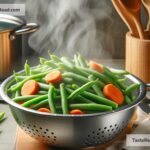Understanding How Boiling Impacts the Texture of Fibrous Vegetables
Vegetables are an important part of a healthy diet, providing essential nutrients, vitamins, and fiber that keep your body strong and energized. But have you ever noticed how vegetables that are raw and crunchy turn soft and tender after cooking? This transformation happens because of how cooking, especially boiling, alters their structure. In this article, we’ll explore how boiling affects the texture of fibrous vegetables, using simple terms to make it easy to understand.
What Are Fibrous Vegetables?
Fibrous vegetables, like celery, asparagus, broccoli, carrots, and green beans, are rich in dietary fiber. Fiber is a tough, indigestible part of plant foods that makes them sturdy and firm. It helps with digestion and keeps your gut healthy. These vegetables often have thick cell walls, made of compounds like cellulose, hemicellulose, and lignin, which give them strength and structure.
Raw fibrous vegetables are crisp because the cells inside them are filled with water and surrounded by firm walls. When you bite into raw carrots or celery, you can feel their satisfying crunch. But when you cook them—especially by boiling—this firmness changes, giving the vegetables a softer texture.
The Science of Boiling
Boiling is one of the simplest ways to cook vegetables. It involves submerging them in hot water, usually at a temperature of 100°C (212°F). The heat and water work together to change the vegetables’ structure, making them easier to chew and digest.
When fibrous vegetables boil, three major processes happen that affect their texture:
- Cell Wall Breakdown
The cell walls of fibrous vegetables act like a protective barrier, keeping them strong and firm. These walls are made up of cellulose, hemicellulose, and pectin—tough materials that resist chewing in their raw form.
When vegetables boil, the heat weakens the bonds between these compounds, causing the cell walls to break down. This is why tight, crisp vegetables start to feel tender. Cellulose and hemicellulose soften, and pectin dissolves into the water, making the vegetable less stiff.
- Loss of Water Pressure
Inside the cells of raw vegetables, there’s a high water pressure called “turgor pressure.” Think of this pressure as what makes the vegetable “stand tall” and stay crunchy. When you boil vegetables, their water-filled cells lose some of their moisture.
This happens because heat opens up the channels on the cell walls, allowing water and other substances to escape. As the turgor pressure decreases, the vegetables become limp and tender. This is especially noticeable in leafy greens and beans after boiling.
- Starch Gelatinization
Some fibrous vegetables, like carrots and potatoes, contain starch in their cells. Starch is a carbohydrate that becomes soft and jelly-like when exposed to heat and water.
During boiling, the heat causes the starch molecules to absorb water and swell, making the vegetable smoother and softer. This is part of what gives boiled carrots their creamy texture, compared to their raw, crunchy state.
Benefits of Boiling Fibrous Vegetables
Boiling fibrous vegetables has several advantages. Here’s why you might want to boil your veggies:
-
Easier to Eat and Digest
Boiling softens tough vegetables, making them easier to chew and digest. If you’ve ever struggled to eat raw broccoli or green beans, boiling can make them much more palatable. -
Improved Flavor
Cooking can bring out the natural sweetness in vegetables as the starches break down into sugars. For example, boiled carrots and sweet potatoes taste sweeter than their raw counterparts. -
Nutrient Availability
Boiling can improve the bioavailability of certain nutrients. For instance, cooking tomatoes boosts the levels of lycopene, a powerful antioxidant that promotes heart health.
Downsides of Boiling
While boiling has its benefits, it’s important to know its downsides:
-
Loss of Nutrients
Some nutrients, like vitamin C and B vitamins, are water-soluble, meaning they dissolve in water. When vegetables are boiled for too long, these nutrients can leach out into the cooking water. To reduce nutrient loss, avoid overboiling and consider using the water in soups or sauces. -
Over-softened Texture
If boiled too long, fibrous vegetables can become overly mushy, losing their flavor and appeal. Timing is key to achieving the perfect balance between tenderness and texture.
Tips for Boiling Vegetables
To get the best texture from boiled fibrous vegetables, keep these tips in mind:
-
Cook in Small Batches
Don’t overcrowd your pot; each piece should be submerged evenly in the water. -
Don’t Overcook
Boil just long enough to make the vegetables tender but not mushy. Check with a fork to see if they’re done. -
Add Salt to the Water
Enhancing the flavor of boiled vegetables can be as simple as adding a pinch of salt to the water. -
Use Ice Water for Crispiness
To preserve some crunch, plunge boiled vegetables into ice water after cooking. This is known as blanching and can help stop the cooking process quickly.
Final Thoughts
Boiling is a simple and effective way to cook fibrous vegetables, transforming their texture from crisp to tender. The heat breaks down their cell walls, reduces water pressure, and gelatinizes starch, making the vegetables easier to eat, digest, and enjoy. Just remember not to overboil them—timing is everything! With the proper techniques, boiled vegetables can be a delicious and nutritious addition to your meals.

